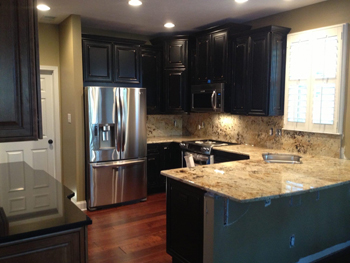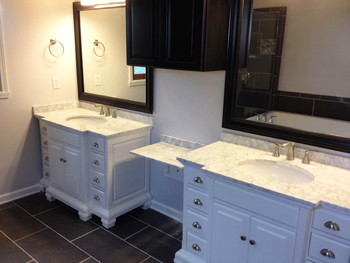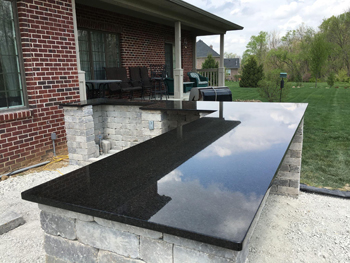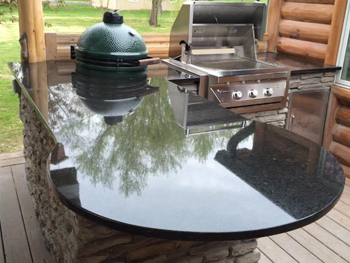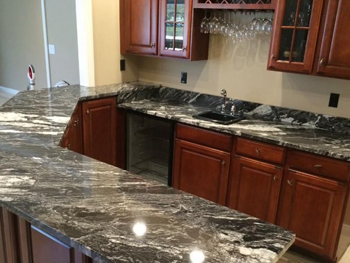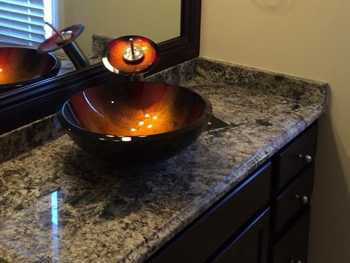Frequently Asked Questions
We have put together some of the most common questions we get about granite, we hope you find this collection of questions useful but should you have ANY additional questions. Please do not hesitate to give us a call at 317-575-8883 or drop us an Email at CLASSICKITCHENANDGRANITE@GMAIL.COM
Typically about 2 or 3 weeks.
While not as hard as granite, it is less brittle, so it won’t crack unexpectedly from stress or weight. Soapstone is also very non-porous.
No – Quartz can only handle about 400 degrees, placing a freshly hot pan on it can damage and cause permanent damage to the surface.
Granite is harder than marble, making it more resistant to stains and scratches.
Quartz is actually harder than granite, making it much more durable. It is also easier to keep your counter tops bacteria free as quartz is non-porous.
Quartz is stain resistant but not stain proof. If it does stain, there are products that will remove the stain available.
They are made of approximately 94 percent stone particles (this is how they are able to claim to be stone or have qualities) and 6 percent plastic resin. Crushed granite, quartz, mica and feldspar (usually from a granite quarries stock that is too brittle to be cut into slabs) are mixed with a resin and pressed into slabs or countertops.
Granite is considered to be honed when the polishing process is halted just before a reflective shiny polish is achieved. This gives the material a matte non-reflective appearance. Sometimes polished granite can be honed using special equipment to remove the final polished layer from the surface but this can result in wheel marks and swirls from the polishing heads. Honed material is more susceptible to scratches and is more porous.
Granite is a crystalline structure so it will always have tiny pits or spaces between the various mineral crystals. You usually do not see them on a larger piece because they are so small and the overall appearance is polished and mirror like. Some types of granite can have natural fissures which may look like cracks. These are not structural defects but are naturally occurring markings resulting from the immense heat and pressure that formed the granite. These characteristics are part of the natural beauty of granite and have no impact on the function or durability of the material. Natural products vary and can not be expected to look completely uniform or manmade.
You can have 12 inches of overhang before supports are needed. Overhangs over 12 inches should be supported approximately every three feet. You can use corbels, decorative legs or 1/4″ flat steel brackets.
Standard thickness on granite countertops is 3cm or approximately 1 1/4 inch. Some companies will use 2cm granite to cut costs. Another strip of material can be laminated along the edges to make it appear thicker but this leaves a seam in the middle of the edge than can be very noticeable.
Because granite is a natural material and is mined from the quarry in blocks usually no larger than 10 feet long most kitchens end up with a seam or two. Seams are sometimes needed to allow for transporting the granite pieces through a home. Not all hallways, stairways or corners will allow a large piece through. Where the countertops will have to be carried through, the layout of the kitchen and the size of the granite slabs are the factors which will determine how many seams there will be and where they will be placed. The number and size of the seams should be minimal. The material used to seam two pieces of granite together is colored to match the granite as closely as possible so it is not noticeable. The color and pattern of the granite will often determine how visible the seams are. If the pattern is fairly consistent the seam will be less noticeable than if the granite has a lot of movement and variation as it will be harder to match the pattern exactly at the seam.
No. Granite cannot be burned or scorched with ordinary use. Granite is formed by extreme heat and pressure so it cannot be affected by cooking temperatures. A lit flame placed under the granite will have no melting or scorching effect. You can take a pot of boiling water directly off of the stove or a pan directly out of a 500 degree oven and put it on top of the granite without worrying about leaving any marks. Most cooking takes place at 250 degrees or higher. With that in mind consider the following:
Corian is reported to be able to withstand temperatures up to 212 degrees. When a flame is placed under Corian it will ignite. The manufacturer recommends running cold water anytime you pour boiling water in the sink (straining pasta, potatoes etc.) to avoid warping the sink.
Engineered stones (Silestone, Ceasarstone, Zodiac, Cambria etc.) claim to be extremely heat resistant because they can withstand temperatures up to 225 degrees. The manufacturers of these products tell you not to place hot pots and pans directly on them, especially for long periods of time, since doing so can scorch or warp the material.
Granite is reported to be able to withstand temperatures between 1200 and 1650 degrees. Hot pots and pans can be taken directly from the oven or stove and placed on top of the granite without fear of scorching, burning or warping. You can use crock pots, electric griddles, coffee makers, waffle irons etc. without marking the granite in any way.
No. We use Stain-Proof by Dry Treat. It will typically seals and lasts for 15 years. We do not charge for the first/initial application. If a re-seal is ever needed we sell this treatment for $85.00 per quart.
Granite is a natural stone so it is a slightly porous surface however this does not make it a breeding ground for bacteria. If you keep your granite countertops clean and dry you will not have any bacteria problems. No matter what your countertops are made of, you should never place raw meat on them. If this happens make sure to clean the area thoroughly to avoid cross contamination. If you are still concerned with bacteria you can use anti-bacterial dish soap and very hot water to clean your countertops or use anti-bacterial cleaners or wipes on them. If you use an anti-bacterial cleaner, make sure that it is as ph neutral as possible or you may have to seal your countertops more often.
There are a variety of cleaners on the market today made specifically for granite (some even have sealers built in) however, they are not required. Granite can be cleaned with dish soap and water and then dried with a clean cloth to avoid residue buildup. Cleaners that have a neutral ph can be used as well such as Glass Plus. You want to avoid cleaners that have ammonia or other acidic bases. They will not hurt the granite itself but over time can strip away the sealer.
Not usually. All natural stone is porous to some extent but granite has a very low porosity. Sealers are used to further reduce the porosity and the chance of staining. Different types of granite can have different porosity levels. Sealers are used during the installation process the prevent liquids from immediately penetrating the stone and staining it. It is possible for dark liquids such as red wine or oily products to leave a stain if left to penetrate the granite (usually over several hours). Should this happen, poultice kits can be purchased. A poultice is a paste like substance that is applied to the granite then covered with plastic and allowed to sit to draw the stain out of the granite and into the paste.
Yes. However it will dull your knives if you use your countertops as a cutting surface.
Both are natural stones that are quarried from the earth however granite and marble (and marbles relatives limestone, onyx and travertine) are quite different from one another. Granite is formed deep within the earths mantle at extremely high temperatures making it a very hard resilient stone made of crystallized minerals. The marble family (marble, limestone, onyx and travertine) starts out as sediment (animal skeletons, plant matter & silt) at the bottom of a body of water. Over millions of years this sediment solidifies into stone. Because the main component of these stones is calcium, they can be affected by acids such as vinegar and citrus juice.
Granite is the second hardest natural material on earth, the first being diamonds. This is why diamond tipped blades are needed to cut through granite.
